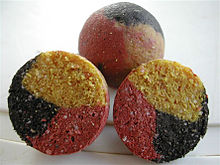
Trolling is a method of fishing where one or more fishing lines, baited with lures or bait fish, are drawn through the water at a consistent, low speed. This may be behind a moving boat, or by slowly winding the line in when fishing from a static position, or even sweeping the line from side-to-side, e.g. when fishing from a jetty. Trolling is used to catch pelagic fish such as salmon, mackerel and kingfish.

Angling is a fishing technique that uses a fish hook attached to a fishing line to tether individual fish in the mouth. The fishing line is usually manipulated via a fishing rod, although rodless techniques such as handlining also exist. Modern angling rods are usually fitted with a fishing reel that functions as a cranking device for storing, retrieving and releasing out the line, although Tenkara fishing and traditional cane pole fishing are two rod-angling methods that do not use any reel. The fish hook itself can be additionally weighted with a denser tackle called a sinker, and is typically dressed with an appetizing bait to attract and entice the fish into swallowing the hook, but sometimes an inedible fake/imitation bait with multiple attached hooks is used instead of a single hook with edible bait. Some type of bite indicator, such as a float, a bell or a quiver tip, is often used to relay underwater status of the hook to the surface and alert the angler of a fish's presence.
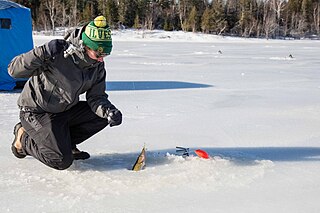
Ice fishing is the practice of catching fish with lines and fish hooks or spears through an opening in the ice on a frozen body of water. Ice fishers may fish in the open or in heated enclosures, some with bunks and amenities.

A fishing lure is any one of a broad category of artificial angling baits that are inedible replicas designed to mimic prey animals that attract the attention of predatory fish, typically via appearances, flashy colors, bright reflections, movements, vibrations and/or loud noises which appeal to the fish's predation instinct and entice it into gulping the lure. Angling activities using lures are known as lure fishing.

A fish hook or fishhook, formerly also called an angle, is a hook used to catch fish either by piercing and embedding onto the inside of the fish mouth (angling) or, more rarely, by impaling and snagging the external fish body. Fish hooks are normally attached to a line, which tethers the target fish to the angler for retrieval, and are typically dressed with some form of bait or lure that entices the fish to swallow the hook out of its own natural instinct to forage or hunt.

The Hair rig is a fishing method which allows a bait to be presented without sitting directly on the hook. It is mainly associated with boilies, but also works effectively with many other baits. The Hair-Rig became popular in the 1980s and was the joint invention of Len Middleton and Kevin Maddocks.
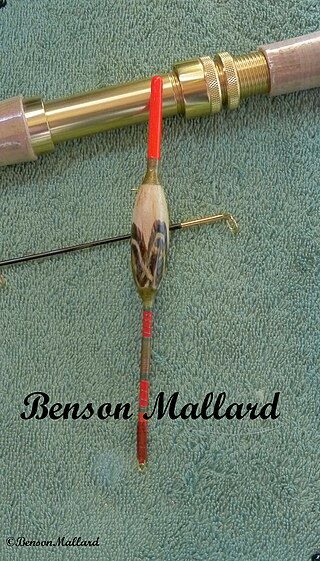
Shortfloating or Short fishing is a fishing method that has been employed in running water by river anglers for many decades, and is also used by lake anglers. The method that allows the angler to selectively target species of fish by controlling hook length. Short floating is used in the river pools alongside runs, where resting fish have time to consider and take bait.
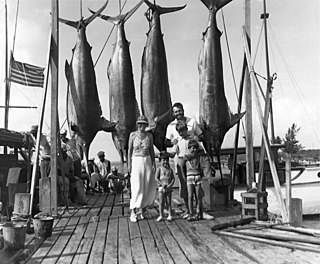
Marlin fishing or billfishing is offshore saltwater game fishing targeting several species of fast-swimming pelagic predatory fish with elongated rostrum collectively known as billfish, which include those from the families Istiophoridae and Xiphiidae (swordfish). It is considered by some fishermen to be a pinnacle of big-game fishing, due to the size, speed and power of the billfish and their relative elusiveness.

A fishcake is a culinary dish consisting of filleted fish or other seafood minced or ground, mixed with a starchy ingredient, and fried until golden.

Fishing tackle is the equipment used by anglers when fishing. Almost any equipment or gear used in fishing can be called fishing tackle, examples being hooks, lines, baits/lures, rods, reels, floats, sinkers/feeders, nets, spears, gaffs and traps, as well as wires, snaps, beads, spoons, blades, spinners, clevises and tools that make it easy to tie knots.

Coarse fishing is a phrase commonly used in Great Britain and Ireland. It refers to the angling for rough fish, which are fish species considered undesirable as food or game fish. Freshwater game fish are all salmonids, particularly salmon, trout and char. Generally, coarse fish are freshwater fish that are not salmonids, though there is often disagreement over whether grayling should be classified as a game fish or a coarse fish.

Groundbait is a fishing bait that is either thrown or "balled" into the water in order to olfactorily attract more fish to a designated area for more efficient catching via angling, netting, trapping, or even spearing and shooting. Groundbaits are typically scattered separately from the hook and usually before even casting any rod or net, although in bottom fishing they can be deployed synchronously with hookbaits while contained inside a gradual-release device also attached to the fishing line known as a method feeder.
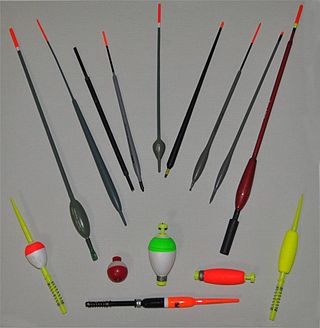
A fishing float or bobber is a lightweight buoy used in angling, usually attached to a fishing line. Angling using a float is sometimes called float fishing.

Soft plastic bait, commonly known as soft lure, soft plastics, plastic bait, worm lure or just worm, is any of a range of elastomer-based fishing lures termed so because of their flexible, flesh-like texture. Soft lures are available in a large range of colours, sizes and particularly shapes, and are typically impaled directly onto a fishing hook like an ordinary bait.
A sabiki or flasher rig is typically fished off boats, piers, jetties, or any structure over the water. Sabikis consist of any number of small hooks, each one on individual dropper lines that are a few inches long. The individual dropper lines are then tied to a longer leader in series, about 6 inches (15 cm) apart; a weight is tied to the end of the leader. Alternatively, a larger lure or plug can be used at the end. This creates the illusion that a medium-sized fish is chasing 6 to 10 smaller fish.
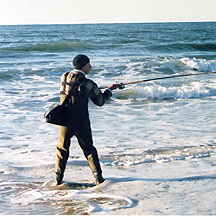
Surf fishing is land-based game fishing while standing on the shoreline or wading into the surf zone. A general term, surf fishing may or may not include casting a lure or bait, and refers to all types of shore fishing – from sandy and rocky beaches, rock jetties, or even fishing piers. The terms surfcasting or beachcasting refer more specifically to surf fishing from the beach by casting into the surf at or near the shoreline. With few exceptions, surf fishing is done in saltwater. The most common misconception about surf fishing is the idea that one must cast as far out as possible in order to reach the fish. At beaches on the west coast of the United States, and in fact, at most beaches around the world, you only really need to get your bait into knee-deep water. This is referred to as surf fishing the "skinny".
A pellet waggler is a small, dumpy float used for fishing. It is suited for any small particle baits, but can also be used for larger baits such as cut cubes of meat. Its main use is to present a bait near the surface of the water, usually in the top 60 cm. When fishing deeper than 60 cm it is better to fish with a normal waggler.

Fishing bait is any luring substance used specifically to attract and catch fish, typically when angling with a hook and line. There are generally two types of baits used in angling: hookbaits, which are directly mounted onto fish hooks and are what the term "fishing bait" typically refers to; and groundbaits, which are scattered separately into the water as an "appetizer" to attract the fish nearer to the hook. Despite the bait's sole importance is to provoke a feeding response out of the target fish, the way how fish react to different baits is quite poorly understood.

Carp is a common name for various species of freshwater fish from the family Cyprinidae that are native to Eurasia and sought after by some recreational fishermen. Certain carp species have been introduced, with mixed results, to various other locations around the world, and even declared invasive in certain regions.
The chod rig is a fishing rig for carp fishing, generally regarded as having three main advantages: the way in which it allows a bait to be displayed over soft mud, weed or debris; and the way its distinct shape allows the chosen bait to be attached. The latter benefit is also generally utilised in the chod rig's immediate ancestor, the stiff-hinged rig. It revolves around a rig consisting of a rigid or stiff link, an aggressively angled hook point and the ability to spring 360 degrees around the axis of the hook. The third benefit is it makes carp fishing almost impossibly easy requiring little skill or effort for large rewards. The only requirement is to soak the baits for long enough until a carp finds it.
